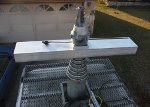|
OK, I have seen 2 posts/emails just today on gents thinking of throwing an 8 watt amp into their system. So this has got to be posted. BBHN uses microwaves, which act totally different from the low-n-slow bands. It REQUIRES point-to-point links with CLEAR Line of Sight and UNOBSTRUCTED Fresnel zones. If you are unsure of these 2 definitions, please Google/Bing/Your favorite search engine before moving on. The trick to making a good mesh network is aiming GOOD antennas FIRST. If you have a clear path, clear Fresnel, and a good antenna, you can go MILES with ONLY STOCK POWER (79mW/19dbm) IT HAS BEEN DONE. If you get a link, but it is real flaky, then maybe bump it up with a half-watt amp. If its still not solid, then go to 1W. No more than 2 watts should EVER be necessary. If it takes more than 2 watts, then maybe you should rethink your paths. Can you add a repeater node in between? Can you raise the antennas higher to get over the obstructions? But planning an 8W amp before even TRYING to make the link is foolish and can be downright dangerous. I wont intentionally walk in front of a 24dbi dish even with just stock 79mW into it. My contact lenses (and EYES) are expensive, and the concentrated microwaves will COOK water (coffee cup in the Radarange should be proof enough every morning!). Safety is the first (or second) lesson for a Technician license.
Im not trying to belittle or chastise anyone, just bringing to the forefront the dangers of old HF/VHF habits when working in the microwave range. Satellites shoot signals thousands/millions/billions of miles, and what is the transmitters max output? 2, 3, 5 watts? Yes, that is in free space vacuum, but it is the same principals and physics, even with air as an attenuator. Sit down and figure out your path profiles and calculate the RF gains/losses. RadioMobile is a great tool to start with. Heywhatsthat (link under web links-path profiling) is another great profiling tool.
An 8 watt amp into a 24Dbi dish nets an EIRP of 2+KW. If you need that much, invest in a chainsaw first (to remove obstructions). At least you can see where the stuff is flying off it's blade. And remember the one big Part 97 rule: USE THE LEAST AMOUNT OF POWER TO MAKE YOUR CONTACT. IMHO, An 8 Watt amp should be considered illegal under this rule. Get a better antenna first ! Get more HAAT second. Add a relay node third. We are Hams... we are supposed to be creative! And with SAFETY always in mind.
We have done 5, 6, and 10 mile SOLID links across Austin, the Texas capitol, which include the University of Texas campus, with business and residential wifi, microwave ovens, and other 2.4 Ghz QRM present, with just gain antennas on each end and NO AMPLIFIERS. I will close with my urging everyone planning mesh networks to realize this is not HF/VHF/UHF, and it works differently. You cannot change how it works, you have to plan the way it works. And most of all do it safely. 73 and Happy Meshing
Jim
K5KTF |
